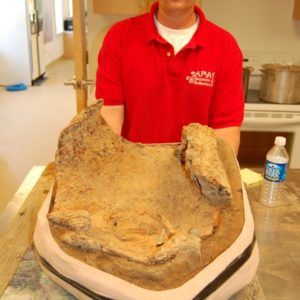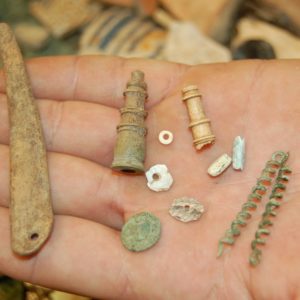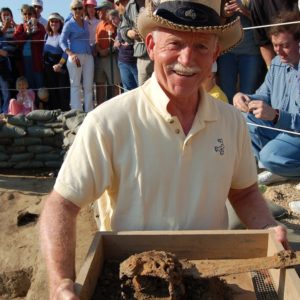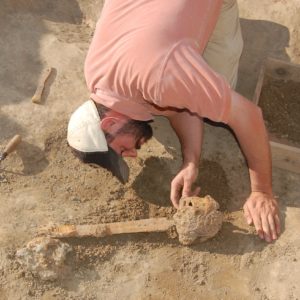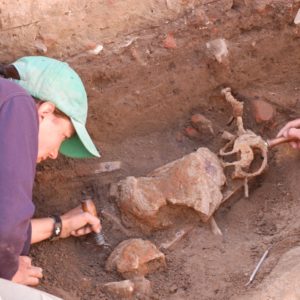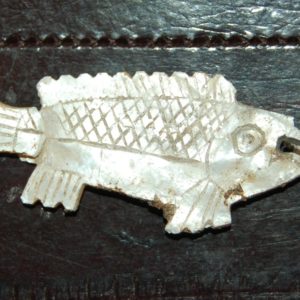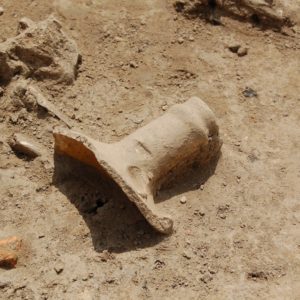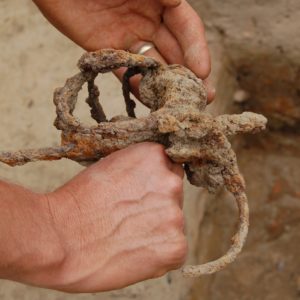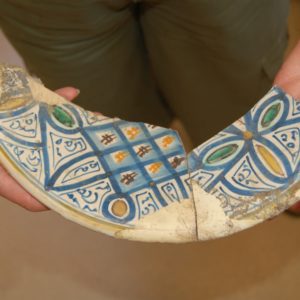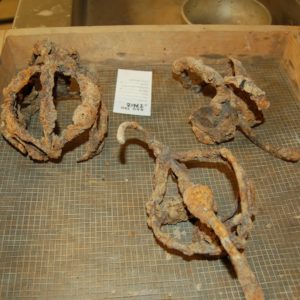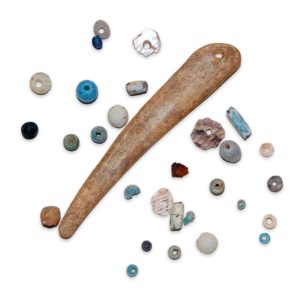A single grave in the current excavation area, about 200 ft. from the existing 17th-century church tower, appears to be contemporary with 21 other graves in a nearby 1607 burial area, but it is separated from them by a blank area of about 15 ft. where the soil has not been disturbed. The separation is a mystery that archaeologists hope to solve as more of the area is exposed. One theory is that the blank space may indicate the presence of a building, possibly the first church, which was located in “the midst” of the fort, according to historical accounts. Danny Schmidt, Senior Archaeologist, said it would also make sense to find the church near the graveyard.
Meanwhile near the north corner of the fort, archaeologists are continuing to excavate the artifact-rich feature, possibly a cellar or well that contained a cache of arms and armor including eight sword hilts, a breast plate, tasset lames (armor that protects the thigh), and a nearly complete broadsword with an intact basket hilt—only a portion of the blade was missing. The objects were discovered about 3 feet below the 17th-century ground level inside a 16 x 16 ft. pit.
Bill Kelso, Director of Archaeology, says the cache may also be an indication that some armor, such as breastplates, was no longer useful to the colonists. Kelso said they have uncovered evidence that the colonists were making or repairing lighter, more flexible jacks of plate, with overlapping plates of armor that provided better protection against arrows than the “tin can” design of the breastplate.
“This discovery is relevant to what’s happening with the military today,” he said. “Soldiers are looking at replacing armor currently issued with ‘Dragon Skin’—armor designed with overlapping scales to provide better protection. It reminds me of the saying, ‘Those that don’t know history are doomed to repeat it,’ and it underscores the importance of what we can learn from archaeology. It appears that the same thing happened here 400 years ago,” he said.
At first, because of the way the layers of debris slumped toward the center of the pit, archaeologists thought it might be a well, but they have recently uncovered more clearly defined edges along the sides of the pit that are beginning to suggest that it may have been a cellar or pit.
It’s at least 6 ft. deep, but they haven’t found the bottom or a well shaft, yet. It is also an early fort period feature that appears to be aligned with the wall of the fort. The pit is below the foundation to an addition to the first governor’s house, and the latest artifact is a 1613 English farthing found near the top of the pit.
Rich with artifacts, so far the pit has yielded glass trade beads, baubles, ivory chess pieces, iron objects, a locally made pipe with the initials EG, pewter spoons, a Surrey-Hampshire Border ware candlestick, and pottery sherds that date to the early years at James Fort. Virginia Indian artifacts have also been unearthed, including a grinding stone, and finished and unfinished shell beads. A bone needle that may have been used by either culture was also uncovered.
Other intriguing artifacts discovered recently from the feature include remnants of fabric, possibly canvas; a decorative mother-of-pearl fish, possibly a tropical Cichlid, about 1.5 inches long with a brass link that passes through a hole in its head; and portions of a late-16th century, tin-glazed Montelupo dish, about 11″ in diameter.
The colorful dish fragments are an especially exciting find, according to Bly Straube, Senior Curator. Straube said there were very few dishes at Jamestown. Plates were used occasionally by the upper class for plated meals and to display as a reflection of their status. The dish shows no evidence of being used for dining, and a suspension hole in the rim indicates that it was intended for display. Lower class colonists would have used wooden vessels for potages and stews. These did not survive for archaeologists to discover, except for one bowl that was found near the bottom of a well.
Schmidt said they have unearthed numerous pig bones in addition to an abundance of wild animal bones, which is indicative of the early years of the colony when wild animals were also an important component of the colonists’ diets. Food remains found by archaeologists in the pit include oyster shells, sturgeon scutes and crab claws, as well as fish, bird, turtle, deer, pig, cow, and goat remains.
related images
- Back plate excavation
- Conservator Dan Gamble displays the breastplate before conservation efforts begin
- Artifacts recovered from the cellarwell feature a bone needle, ivory chess pieces, a 1613 English farthing, Virginia Indian shell beads, and glass trade beads
- Director of Archaeology Bill Kelso holds a broadsword excavated from the cellar/well feature
- Senior Conservator Michael Lavin carefully excavates the broadsword
- Sword hilts in the pit feature
- Candlestick holder
- Decorative mother-of-pearl fish discovered in the cellar/well feature
- Fragment of a pipkin
- One of the rapier hilts excavated from the cellar/well feature
- Portions of a late-16th century, tin-glazed Montelupo dish, about 11 inches in diameter
- Three sword hilts
- Bone needle used by colonists or Indians and various trade beads




